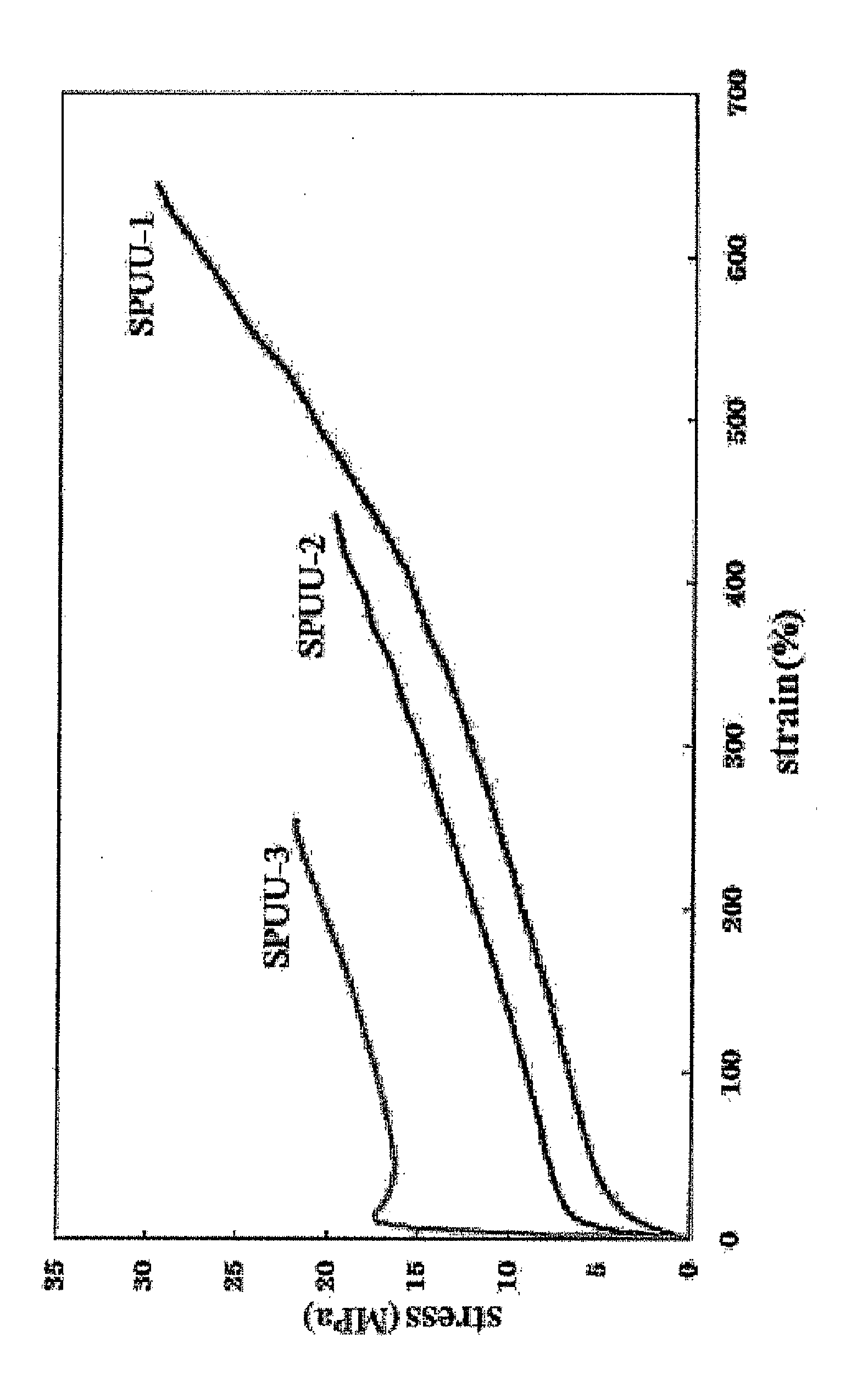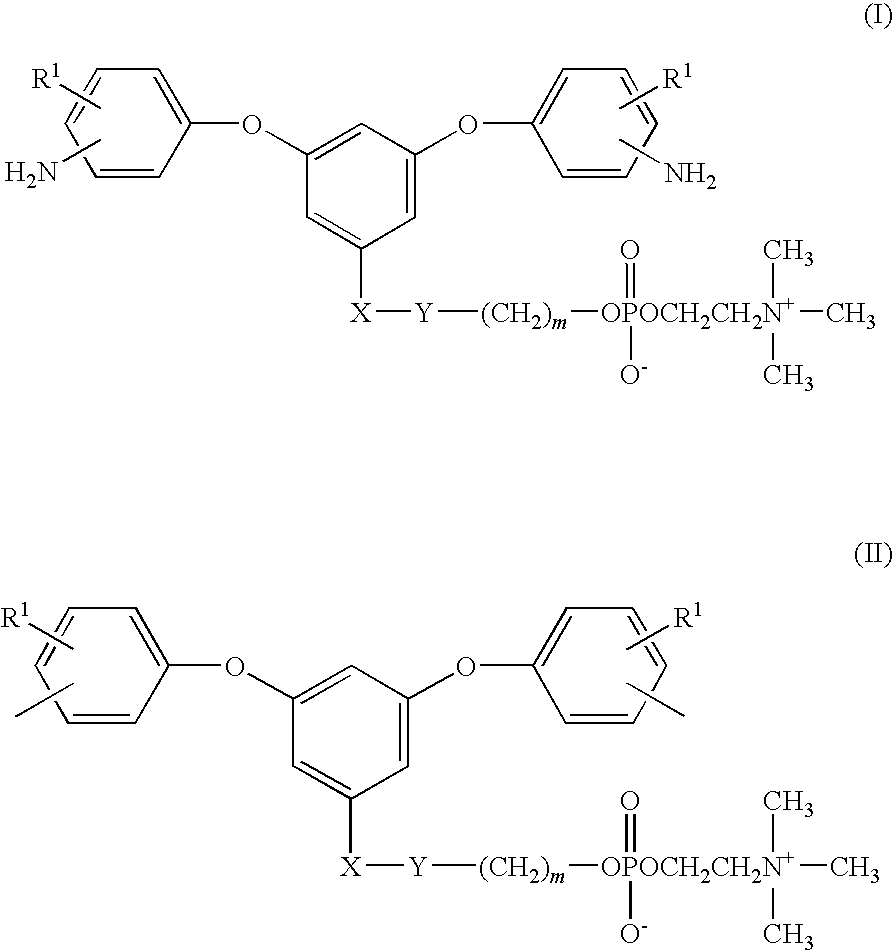Diamine Compound Having Phosphorylcholine Group, Polymer Thereof, and Process for Producing the Polymer
- Summary
- Abstract
- Description
- Claims
- Application Information
AI Technical Summary
Benefits of technology
Problems solved by technology
Method used
Image
Examples
example 1
Synthesis 1 of Diamine Compound According to the Invention
[0087]
[0088]In an evaporation flask, methyl 3,5-dihydroxybenzoate (5.00 g, 29.7 mmol) was dissolved in dimethylacetamide (50 ml). 4-Fluoronitrobenzene (8.39 g, 59.5 mmol) andpotassium carbonate (8.22 g, 59.5 mmol) were added to the solution, and reaction was carried out at 85° C. for 5 hours. After the completion of the reaction, the solution was poured into an excess of distilled water, and the resultant precipitate was suction filtered and was heat vacuum dried to give a compound (1) as a white solid (weight: 10.4 g, yield: 85.4%). The structure of the compound was determined from the 1H-NMR and IR spectra given below:
[0089]1H-NMR, δ (400 MHz, DMSO-d6, ppm): 8.28 (4H, m), 7.53 (2H, s), 7.32 (1H, s), 7.27 (4H, m), 3.85 (3H, s).
[0090]IR, ν (KBr, cm−1): 3120, 3082, 1709 (C═O), 1604, 1582, 1520, 1508, 1489 (—NO2), 1441, 1352 (—NO2), 1308, 1232, 1220 (C—O—C), 1167, 1126, 1105, 1005, 993, 851, 773, 750.
[0091]In an evaporation fla...
example 2
Synthesis 1 of Polymer (Homopolymer) According to the Invention
[0106]
[0107]In an argon atmosphere, the compound (6) from Example 1 (0.500 g, 0.789 mmol) and sodium hydrogencarbonate (0.133 g, 1.58 mmol) were dissolved in distilled water (2.63 ml) in a three-necked flask. A solution of 2,2-bis[(4-(4-chlorocarbonylphenoxy)phenyl]propane (0.400 g, 0.789 mmol) in chloroform (2.63 ml) was added dropwise to the solution over a period of 20 to 30 seconds to perform interfacial polycondensation. The resultant precipitate was sufficiently washed with methanol, suction filtered and dried under reduced pressure to give a polyamide with a phosphorylcholine group represented by Formula PA-1 above as a brown solid (weight: 0.619 g, yield: 73.4%). The structure of the polymer was determined from the IR spectrum given below:
[0108]IR, ν (KBr, cm−1): 3422 (N—H), 2959, 1653 (CO), 1499, 1437, 1406, 1242 (PO), 1207 (C—O—C), 1169, 1115, 1010, 947, 840, 760.
[0109]The molecular weight of the polymer PA-1 w...
example 3
Synthesis 2 of Polymer (Copolymer) According to the Invention
[0112]
[0113]In an argon atmosphere, the compound (6) from Example 1 (0.167 g, 0.263 mmol), hexamethylenediamine (0.275 g, 2.37 mmol) and sodium hydrogencarbonate (0.442 g, 5.26 mmol) were dissolved in distilled water (8.77 ml) in a three-necked flask. A solution of isophthalic acid chloride (0.534 g, 2.63 mmol) in chloroform (8.77 ml) was added dropwise to the solution over a period of 20 to 30 seconds to perform interfacial polycondensation. The resultant precipitate was sufficiently washed with methanol, suction filtered and dried under reduced pressure to give a polyamide copolymer with a phosphorylcholine group represented by Formula CPA-1 above as a yellow solid (weight: 0.697 g, yield: 88.9%). The structure of the copolymer was determined from the IR spectrum given below. From the 1H-NMR spectrum, the copolymerization ratio (on amolar basis) of the copolymer CPA-1, x / y, was 90 / 10.
[0114]IR, ν (KBr, cm−1) 3329 (N—H), 3...
PUM
| Property | Measurement | Unit |
|---|---|---|
| Mechanical strength | aaaaa | aaaaa |
| Molecular weight | aaaaa | aaaaa |
| Thermal resistance | aaaaa | aaaaa |
Abstract
Description
Claims
Application Information
 Login to View More
Login to View More - R&D
- Intellectual Property
- Life Sciences
- Materials
- Tech Scout
- Unparalleled Data Quality
- Higher Quality Content
- 60% Fewer Hallucinations
Browse by: Latest US Patents, China's latest patents, Technical Efficacy Thesaurus, Application Domain, Technology Topic, Popular Technical Reports.
© 2025 PatSnap. All rights reserved.Legal|Privacy policy|Modern Slavery Act Transparency Statement|Sitemap|About US| Contact US: help@patsnap.com



